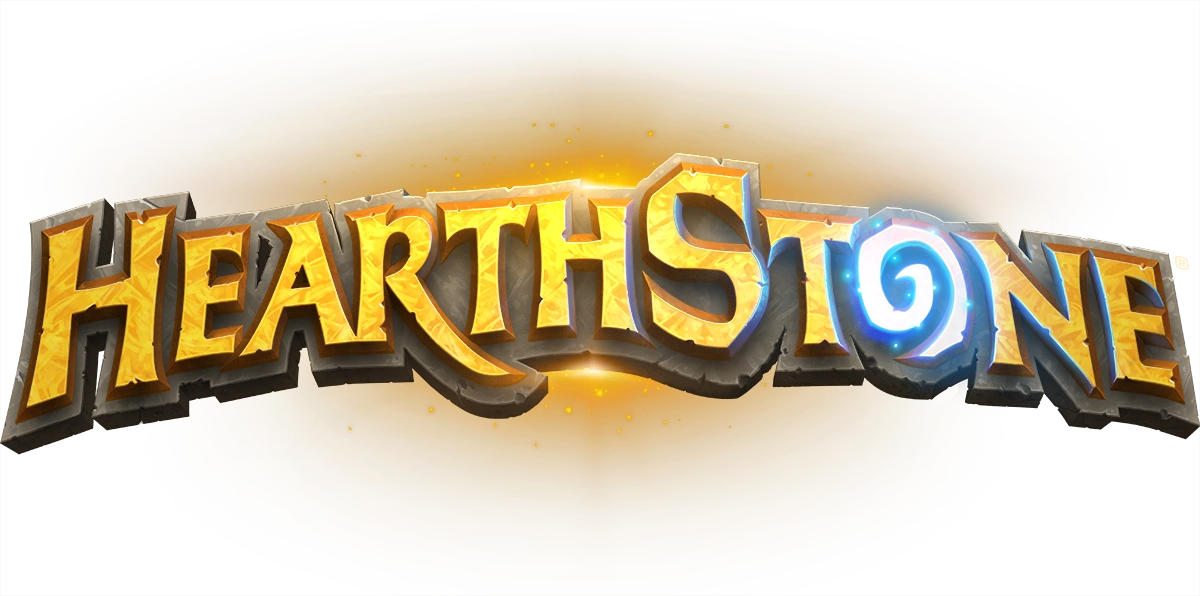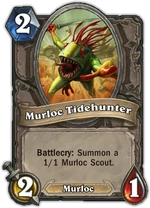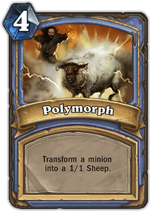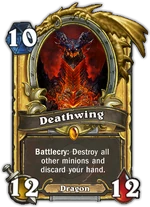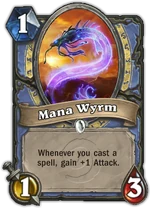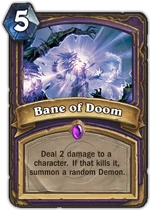| Hearthstone: Heroes of Warcraft | |
|---|---|
|
File:Hearthstone-gamebox.png | |
| Developer(s) | |
| Publisher(s) | Blizzard Entertainment |
| Platforms |
Microsoft Windows, Mac OS X, iPad (current) Android, iPhone, Windows 8 Touch (planned) |
| Release |
Release - March 11, 2014 Open Beta - 21 January, 2014 Closed Beta - 16 August, 2013 |
| Latest release | 1.3.0.6898 (Released) |
| Genre(s) | CCG |
Hearthstone: Heroes of Warcraft is a free-to-play, digital card game set in the Warcraft universe. It was announced on March 22, 2013 at PAX East 2013,[1] and entered closed beta in the Americas region on August 16th 2013, and in the European region on September 4th 2013.[2] The game entered open beta worldwide on January 21st, 2014,[3] and was fully released March 11th, 2014.[4]
Hearthstone is available on Microsoft Windows and OS X operating systems, and on iPad, supporting iPad Air, iPad 4th generation, iPad 3rd generation, iPad 2, iPad mini, and iPad mini with Retina display.[5] Hearthstone is planned to available for Android, iPhone, and Windows 8 Touch with the Android coming in December 2014.[6]
In Hearthstone, players can choose to play as one of nine legendary Warcraft heroes, taking turns to play cards from their customizable decks to cast potent spells, use heroic weapons or abilities, or summon powerful minions to crush their opponent.
Players can compete for glory and standing in the game's Ranked Play mode, battle legendary bosses from World of Warcraft's history in adventure mode, or forge a unique deck of randomly selected cards in the Arena, and can complete quests and earn prizes to gain gold and powerful new cards for their collection, constructing formidable decks with which to do battle. Hearthstone is designed to be a quick and accessible card game, that nonetheless features substantial strategic depth for more serious players.
Game details
Hearthstone is a collectible card game that revolves around turn-based online 1vs1 matches between two opponents, operated through Blizzard's Battle.net. Players can do battle as one of nine classes, with each offering its own strengths, powers and synergies, and can create their own custom decks from their card collections.
Players start the game with a substantial collection of 'basic' cards, but can gain rarer and more powerful cards through purchasing packs of additional cards, or as reward for competing in the Arena. Card packs and entry to the Arena can be purchased using real money, or gold, an in-game currency earned through completing special quests. Players can choose from a number of game modes, with each offering a slightly different experience.
Hearthstone is set within the Warcraft universe, with its characters, abilities and items drawing from existing lore. The game features detailed card art, much previously used for the World of Warcraft Trading Card Game, and uses infamous quotes and comical soundbites to bring to life many well-known characters from the franchise's history. Hearthstone also features colourful visuals and animated game boards, with interactive features to entertain players between rounds.
Matches
Each Hearthstone battle is a 1vs1 match between two opponents. Gameplay in Hearthstone is turn-based, with players taking turns to play cards from their hand, casting spells, equipping weapons, or summoning 'minions' to do battle on their behalf. Play may be between two human players, or one player and a computer-controlled opponent.
Each player is represented by their chosen 'hero', an important character from Warcraft lore. Each hero represents a particular class, determining the special cards and unique hero power available to them. Each hero has 30 Health - if that number is reduced to zero, the hero is destroyed, and the controlling player has lost the game. For a list of heroes and classes, see below.
At the start of each turn, the player draws a new card from their deck - a collection of 30 cards selected before battle. Players can choose to play using one of several pre-assembled 'basic' decks, or one of their own custom-made decks. While most cards are available to heroes of any class, a substantial portion are limited to a specific class, giving each hero their own strengths and unique possibilities.
During their turn, each player can choose to play any of their cards, use their hero power, command their minions to attack targets, or or attack directly using their hero, if they have a weapon equipped. However, which actions the player is able to take is partly determined by their mana. Each player starts the game with 0 mana crystals, but gains one at the start of each turn, until the maximum of 10 is reached. Each card and hero power requires the player to expend a specific amount of mana in order to play it, strategically limiting each player's actions. In addition, the larger mana pools in later rounds allow players to play increasingly expensive cards, opening the game up to ever more impressive moves and powerful abilities.
A match is concluded when one or both players has reached zero health, or chooses to concede. Completing a battle will grant each player's hero experience (with additional experience granted for winning) and can allow players to complete quests and earn gold. Winning games can also allow players to earn rewards in Arena and attain higher ranks in Ranked play.
Each match takes place on a randomly selected battlefield, representing the board on which the game is played. There are four possible battlefields: Stormwind, Orgrimmar, Pandaria and Stranglethorn. Each battlefield features its own design and numerous interactive elements, such as catapults that can be loaded and fired, bells that can be rung, windows and boxes that can be knocked at and broken, and lurking beasts that can be driven back into the shadows. However, these elements are purely for entertainment and in no way affect gameplay.
Classes and heroes
Players can choose from 9 classes, representing the original classes from World of Warcraft. Each class is represented by a legendary figure from Warcraft's history.
Class determines which class-specific cards can be used, as well as granting a unique hero power - a special non-card ability which can be used once per turn for 2 mana. Through these mechanics, each class has its own powers, synergies and style. Unlike in World of Warcraft, it is not necessary to create a separate character in order to play as a new class - players can switch at will to a new class, using either a default basic deck or a custom deck of their own construction.
Each hero begins at level 1, and can be raised through earning experience to level 60 (matching the original level cap for World of Warcraft). Every two levels up to level 10 will reward players with a pair of new class-specific cards, similar to the learning of core abilities in World of Warcraft. Above level 10, reaching certain levels will grant golden versions of existing basic cards, a purely cosmetic reward which serves to display the player's progress to opponents in battle.
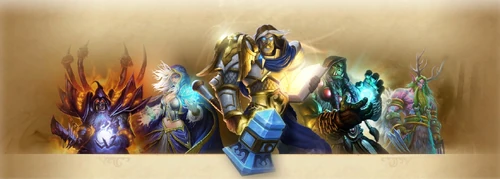
Heroes of Warcraft
Cards
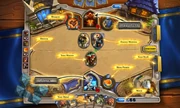
A guide to Hearthstone's user interface.
Cards are the main substance of Hearthstone, representing the abilities, characters and effects which each player is able to make use of during the match. There are currently 465 playable cards in the game, 382 of which can be collected, with more planned to be added to the game later through the introduction of expansions and 'adventures'.
Each player starts the game with a wide selection of 'basic' cards. Cards of higher rarity can be obtained by purchasing card packs, or as reward for success in the Arena. Card packs and entry to the Arena can be purchased using real money, or 'gold', an in-game currency earned through completing special 'quests', such as winning a certain number of matches, or dealing a certain amount of damage. Each card pack consists of five random cards, including at least one 'rare' card. Obtaining new cards allows the player to add them to their decks, opening up new possibilities for play and strategy.
Playing a card consumes mana equal to that card's mana cost, displayed in the top-left corner of each card.
Types
There are three main types of card: minions, spells and weapons.
Minions
Minion cards can be used to summon the described creature onto the battlefield, where they will fight for the player. Minion cards feature an Attack value, reflecting the damage that minion can deal in combat, a Health value, reflecting how much damage the minion can take before being destroyed. Minions are controlled by the player who summoned them, and can be commanded to attack their opponent's minions, or even the opposing hero. Minions with Taunt can act as tanks, preventing the opponent's forces from attacking the hero directly with melee attacks until that minion is destroyed. Minions are a major element in battles between heroes, and are usually responsible for the majority of all damage dealt in a game. Minions are the most common type of card.
Spells
Spell cards are cards that can be played to trigger a one time effect or ability, described in the card's text. In contrast to a minion or weapon card, a spell card will expire immediately after it has been used. Spells include many powerful and useful direct effects, such as damage and removal effects, minion buffs and hidden secret abilities. Spell cards do not have an Attack or Health value.
Weapons
Weapons are special cards which can be equipped by heroes. Each weapon has an Attack value and a Durability value. Each hero can only equip one weapon at a time, and equipping a new weapon will destroy the old one. Attacking using a weapon deals damage equal to its Attack, and reduces its Durability by 1. When a weapon's Durability is reduced to zero, the weapon will be destroyed. All classes except druids, priests and mages have some weapons available to them, with rogues, paladins and warriors generally considered to have the greatest synergy with weapons. Weapons are the least common type of card.
Decks
In all game modes except 'Arena', the player does battle using a deck of 30 cards, constructed from cards in the player's collection. Each deck can only feature two of each card, and only one of each 'legendary' card. Arena play features no such limitations, but requires players to play using a new deck chosen from a series of randomly provided selections. For either type of deck, the construction of a player's deck is a key strategic element in the game, determining which cards are available to them during the course of a match. Each deck is also limited by its chosen class, with class-specific cards only available in decks of the same class.
Players are provided with a basic deck for each class, and can create their own custom decks through the collection manager.
Card set and rarity
In addition to type, cards are divided in two primary ways: card set and rarity.
Card set deals with how a card is obtained. Basic cards are available freely to all players, either being included in their collections from the start of the game, or gained through raising the appropriate class to level 10, while expert cards are obtained through card packs or as Arena rewards. The other card sets, reward and promotions, include a small number of cards available through completing special quests, or in relation to real-world promotions. While basic cards form the foundation for any deck, the most powerful and outlandish cards belong to the expert and other sets.
Rarity refers to a card's overall quality and scarcity. Hearthstone uses a rarity color-scheme similar to that of World of Warcraft, with the exception that there is no 'uncommon' rarity. The rarities and matching colors are therefore free, common, rare, epic and legendary. However, unlike in World of Warcraft, rarity does not directly affect the strength of a card through means such as item level. Rather, rarity tends to roughly illustrate some degree of increased power or utility. A common expert minion will usually bring higher stats or more powerful abilities than a basic minion of the same mana cost, but lower stats or less utility than the equivalent rare or epic minion. Fittingly, legendary cards are especially notable, depicting key characters from Warcraft lore, and typically bring extraordinary powers to the game, such as sourcing new cards directly from the Emerald Dream, or manipulating the very sands of time.
Nonetheless, while higher rarity cards offer an overall advantage over lower rarity equivalents, Hearthstone's tactical nature generally prevents players from winning by rarity of cards alone. While a well-timed star appearance can be enough to tip the scales in the player's favour, not every legendary is considered a strong card, and even Deathwing himself is quite capable of being beaten by a free or common card under the right circumstances.
Crafting and disenchanting
Players can also use the crafting system to create new cards. The system uses 'arcane dust' to craft specific cards. Arcane dust can be obtained as an Arena reward, or by destroying existing cards, allowing players to convert unwanted cards into more desirable options. The crafting system was created as an alternative to the player card trading prevalent in trading card games such as Magic: The Gathering, removing the risk, uncertainty and imbalance found in the trading of cards between players, and providing players with a reliable and direct means of obtaining specific cards, which nonetheless allows players to trade-in their unwanted cards for more desirable alternatives. There are no plans to introduce card-trading between players.
Golden cards
Similar to the 'foils' found in physical collectible card games, Hearthstone features 'golden' cards, special versions of regular cards featuring a golden border and unique animations. These cards are far harder to obtain than their regular versions, and cost more arcane dust to craft. Golden cards differ from their regular counterparts purely cosmetically, and are designed to allow players to show off their accomplishments. Golden basic cards can be obtained by levelling heroes, while golden versions of cards from other sets must be crafted or gained from card packs or rewards.
Acquiring cards
New cards can be earned in several ways. Players begin the game with a substantial collection of basic cards, and can earn further basic class cards through raising each hero to level 10. To collect expert cards, players can either spend gold or real money to purchase card packs directly, or may win packs or individual cards as reward for competing in the Arena. Card packs are packs of 5 random cards, guaranteed to contain at least 1 rare or higher rarity card. Some cards can also be acquired through completing special quests, such as by collecting all murloc minions.
Game modes
Four main game modes are available to play in Hearthstone, with each offering a slightly different set of rules, and its own rewards.
Practice mode
Practice mode allows players to do battle against a selection of computer opponents. Players can choose which class to play against, as well as one of two difficulty settings: basic and expert. Each opponent and difficulty setting features its own deck.
Basic opponents offer players a chance to learn the basics of the game, explore a new class, or prepare for battle in Play mode, and use decks comprising only basic cards. Expert opponents offer a stiffer challenge, giving players the chance to try their hand against decks featuring higher rarity cards and specific plays.
Players can unlock and level heroes in Practice mode, making it the ideal mode for exploring a new class and acquiring its basic cards. The choice of opponent also allows players to focus on problem classes.
Play mode
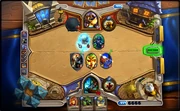
A game of Hearthstone in progress.
Play mode matches players against other human players of similar skill, in random matches. Players can choose to play Casual 'friendly' games, or take part in Ranked play, earning ranks and special rewards to reflect their skill and standing within the community.
Ranked play features a 26-tier rank system, with wins allowing the player to progress to higher ranks, and losses causing them to descend in rank. All ranks are subject to a soft-reset at the end of each season, with each season lasting for one month. Ranked play also provides special cosmetic rewards, including alternate card back designs and animated golden hero portraits.
Arena
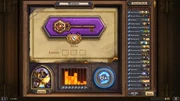
Commencing an Arena run.
The Arena offers a unique challenge, with players forging a new deck from a random selection of cards before using it to do battle in a series of games. A successful run in Arena can offer substantial rewards, including gold, Arcane Dust and card packs, but can be costly and difficult to achieve. Access to the Arena is purchased with gold or real money.
Unlike other game modes, the Arena does not use a pre-made deck, but one that is assembled at the start of that Arena run. Upon entering the Arena the player is given a random selection of 3 classes to choose one. Once a class has been chosen, the player is provided with 30 selections of 3 possible cards, choosing one - and only one - from each selection, slowly building a full deck. Unlike other decks, which are limited to 2 of each card, decks made in Arena may feature any number of the same card. As in any game mode, the strength of the deck constructed is a large part of achieving victory, but Arena's randomised process offers players an additional challenge in anticipating the cards on offer.
Once a deck is constructed, the player is placed in a series of matched games using that deck, although the games do not have to be played all at once. Once the player has won 12 games, or lost 3, the Arena run is ended, and the player is offered a reward determined by their accomplishments that run. Players who do well can reap handsome rewards, but failing to achieve a good run can turn the Arena into an expensive gamble.
Adventures
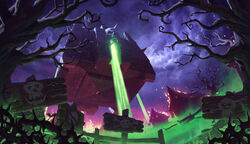
The floating necropolis of Naxxramas in the Curse of Naxxramas trailer
Adventures are a single-player PvE game mode, revolving around special boss encounters. Each adventure has a theme, and brings around 30 new cards to the game, including neutral and class-specific cards.
Adventures feature a selection of battles against computer-controlled bosses, each representing a well-known adversary from Warcraft lore. Each boss presents a unique encounter, featuring special hero powers and decks. Bosses uses a combination of regular cards and boss cards, special and often extremely powerful cards not available to players. Bosses can be encountered in Normal or Heroic mode, and defeating a Heroic boss usually presents quite a challenge, with players needing to devise special decks to counter the mechanics of that specific fight.
Adventures also feature Class Challenges, special class-specific versions of existing boss battles using specific prepared decks.
Adventures offer rewards in the form of new cards to use in the rest of play, as well as a new card for defeating all bosses in Heroic mode.
Curse of Naxxramas
Naxxramas serves as the setting for Hearthstone: Heroes of Warcraft's first adventure: Curse of Naxxramas. The adventure feature encounters with each of the 15 bosses from the raid's second incarnation in both Normal and Heroic mode, offering in reward 30 new Naxxramas-themed cards for use in the rest of the game, featuring ghouls, zombies, nerubians and legendary minion versions of bosses such as Kel'Thuzad, Baron Rivendare and Feugen and Stalagg.
Duels

The official icon of Hearthstone.
Duels allow players to challenge players on their friends list to unranked matches. Duels offer no rewards, save the satisfaction of crushing your friends in combat.
Other game modes
The game also features a Tutorial, a limited and non-repeatable starting experience designed to introduce players to Hearthstone, in which the player is pitched against a series of special opponents, with substantial dialogue elements.
Notes
- The game was also released for iPad, iPhone, Android and Windows 8 Touch versions over the course of 2014.
- The game currently features the 9 playable classes from vanilla World of Warcraft. The death knight and monk classes may be added in the future, but as of January 2014 are not currently being worked on.[7]
Crossover
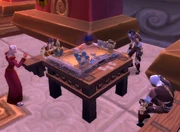
Horde NPCs enjoying a game of Hearthstone
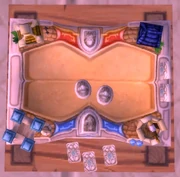
The in-game board from above; compare actual Hearthstone screenshots
From the game's very first announcement, there has been talk of cross-play between Hearthstone and World of Warcraft. During the game's alpha test the developers were already discussing the possibility of allowing players to play Hearthstone from within World of Warcraft.[8] However, no solid plans have yet been announced.
One possible avenue for the eventual introduction of cross-play came with Patch 5.4.0, when two full-sized Hearthstone boards were added to each faction's shrine in the Vale of Eternal Blossoms. These detailed, three-dimensional sets come with cards, mana crystals and even a tiny gryphon on the Stormwind map used by the models. NPCs can be found playing the game from nearby benches and spectating, apparently discussing the game in progress and occasionally cheering the players on. No moving parts are involved, although every so often a small ![]() [Arcane Explosion] occurs above the game board. Players are free to sit on the benches around unoccupied boards, with some roleplayers including games of Hearthstone in their WoW characters' activities. Some have even begun taking their WoW characters over to Hearthstone for some in-character fun with their roleplaying friends and guildmates.[9][10]
[Arcane Explosion] occurs above the game board. Players are free to sit on the benches around unoccupied boards, with some roleplayers including games of Hearthstone in their WoW characters' activities. Some have even begun taking their WoW characters over to Hearthstone for some in-character fun with their roleplaying friends and guildmates.[9][10]
To mark the release of Hearthstone, on March 11th 2014 the ![]() [Hearthsteed] mount was made available to World of Warcraft players as a reward for winning three games in Hearthstone's Play or Arena modes. As a free to play game, this served to encourage WoW players to try Hearthstone, and marked the first significant and rewarding crossover between the two games.
[Hearthsteed] mount was made available to World of Warcraft players as a reward for winning three games in Hearthstone's Play or Arena modes. As a free to play game, this served to encourage WoW players to try Hearthstone, and marked the first significant and rewarding crossover between the two games.
The developers have discussed the possibility of adding further crossover in the future, such as Hearthstone card packs dropping from WoW bosses.
Development
Hearthstone was developed by Team 5, which was formed in 2008. The desire was to create a game in a genre Blizzard had not designed for before, in this case, a card game. It was decided early in development that the game would be based on the Warcraft universe, borrowing creatures, powers, and heroes from the franchise. In this early stage of development, Chris Metzen and Mike Morhaime were enthusiastic about the project, but doubts existed within Blizzard.
Versions of the game were rolled out for internal play within Blizzard layer by layer, steadily giving more and more people access to the game. By December 2012 Hearthstone had gained broad exposure within Blizzard, and there was more confidence in the project. In August 2013 the game entered closed beta,[11] with full release eventually coming in March 2014. As of October 2014, over 20 million people have played the game. It had the internal effect of getting Blizzard to look at the potential for other platforms.[12]
Gallery
- Hearthstone wallpaper1280x1024.jpg
The official Hearthstone wallpaper
Videos
Press information
- Alpha Press Release (2013-03-22)
See also
- This section contains items that is within the World of Warcraft but relates to the card game, Heathstone: Heroes of Warcraft.
 [Hearthsteed]
[Hearthsteed] [Autographed Hearthstone Card]
[Autographed Hearthstone Card] [Hearthstone Strategy Guide]
[Hearthstone Strategy Guide] [Hearthstone Board]
[Hearthstone Board] [Pack of Hearthstone Cards]
[Pack of Hearthstone Cards] [Winning Hand]
[Winning Hand]
References
- ^ http://us.blizzard.com/en-us/news/?d=2013-3#220819
- ^ http://www.wowhead.com/news=218273/hearthstone-closed-beta-now-live-wowheads-hearthstone-database-and-tooltips
- ^ http://www.wowhead.com/news=227064/hearthstone-open-beta-is-here
- ^ Welcome to the Hearthstone Launch!
- ^ Zeriyah 2014-04-16. Hearthstone™ Now Available on iPad®!. Blizzard Entertainment.
- ^ Medievaldragon 2014-11-04. Activision Blizzard Q3 2014 Conference Call – Transcript. BlizzPlanet. Retrieved on 2014-11-05.
- ^ http://www.hearthpwn.com/news/275-dev-interview-new-heroes-gameboards-adventure-mode Dev Interview: New Heroes, Gameboards, Adventure Mode; Legends of Hearthstone BS2W2
- ^ World of Warcraft's Hearthstone could include cross-play, be playable inside WoW. Polygon.com (2013-03-22). Retrieved on 2014-04-01.
- ^ Official Forums - (A-RP)An In-Character Club for Hearthstone Players (2014-03-13)
- ^ Official Forums - Grand AD Hearthstone Tournament (29th March 7PM) (2014-03-16)
- ^ Hearthstone™ Closed Beta Test Begins! (2013-08-16).
- ^ Phillip Kolar. The Three Lives of Blizzard Entertainment. Polygon. Retrieved on 2014-10-04.
External links
| |||||||||||||||||||||||||||||||||||||||||||||||||||||||
| |||||||||||||||||||||||||||||||

